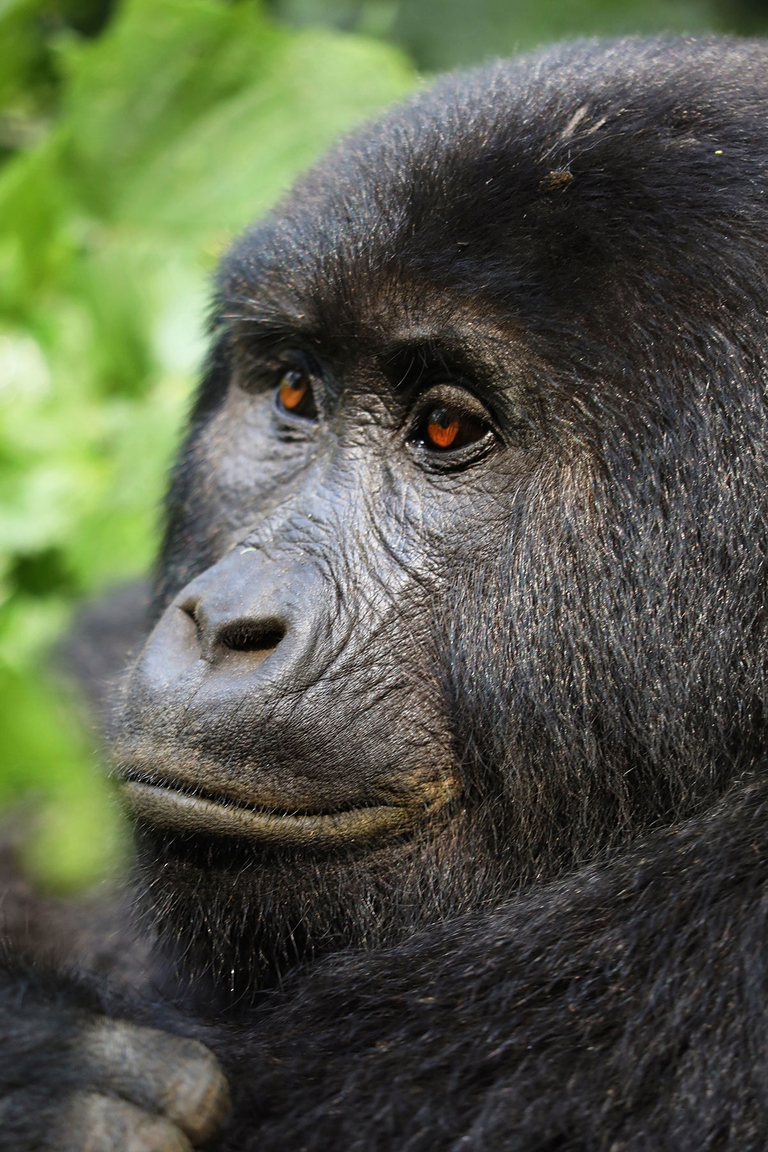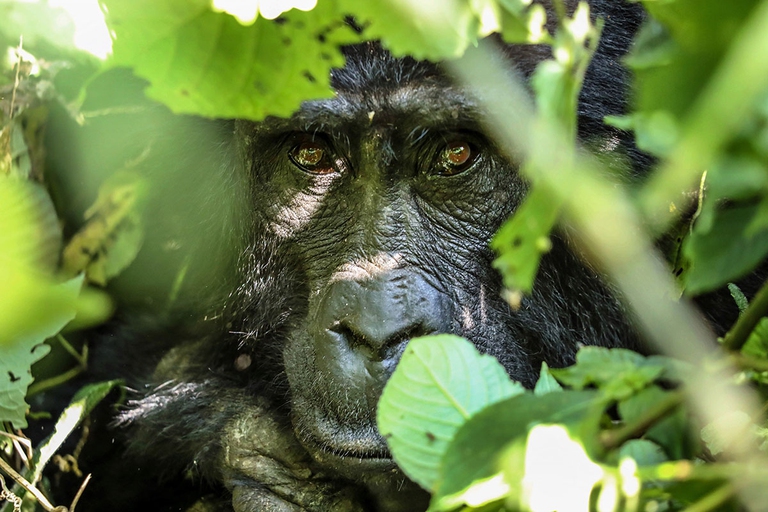
Our species took its first steps in a world covered in trees. Today, forests offer us sustenance, shelter, and clean the air that we breathe.
Mountain gorillas survive in just two places on Earth. The tale of a unique encounter and how to contribute to these animals’ conservation.
Looking a mountain gorilla in the eye stirs up the feeling of having caught a glimpse of your soul, not just because we’re so alike but because we bear the burden of what this animal has endured at our hands. Mountain gorillas survive in just two isolated groups, in as many places on Earth: the Virunga Massif – a chain of volcanoes stretching 280 square kilometres across Rwanda, Uganda and the Democratic Republic of the Congo (DRC) – and the Bwindi Impenetrable National Park in Uganda where we had the immense privilege of seeing them.
These animals most probably oblivious to this but, according to the WWF, a single habituated mountain gorilla can indirectly generate a profit of around 2.5 million dollars during its lifetime from tourist income. Tourism in the areas of the Virunga, Volcanoes and Bwindi national parks has increased dramatically over the past 20 years, with thousands of people visiting to see the gorillas. This isn’t a bad thing if done with regard for the animal, and it has helped transform government and community attitudes towards conservation. Socially and environmentally responsible tourism such as carefully guided trips is crucial for local people to benefit from living in close proximity to gorillas. To ensure this form of tourism is responsibly managed, each habituated gorilla family is visited in its natural environment by just one group of tourists composed of a maximum of eight people per day and for no longer than an hour.
The mountain gorilla (or gorilla beringei beringei) is one of two subspecies of the eastern gorilla, the largest of the living primates. As its name implies, it lives in forests high in the mountains at elevations of 2,500 to 4,000 metres above sea level. Its thick black hair helps insulate it from cold weather, with temperatures often below zero, it has longer hair and shorter arms than its lowland relative, can weigh up to 220 kilos and reach 1 to 2 metres in height. Gorillas are herbivores; they eat roots, shoots, fruit, tree bark and pulp. The mountain subspecies is extremely sociable and lives in troops (the correct name for a group of gorillas) of 2 to 40 led by the silverback, a dominant male who shepherds the other members to the best spots for feeding and resting.
It’s with one of these silverbacks that our unusual but precious encounter took place in July last year. Full disclosure, going to see mountain gorillas isn’t an easy ride. It starts with a long sunrise drive up the windy roads of the Ugandan mountains followed by an exhilarating and incredibly beautiful trek through the high elevation forests in single-file behind the guide; usually rangers find a troop within the three-hour mark.
So-called “trackers”, guides who walk ahead, signal the animals when they spot a troop of gorillas hiding in the thick bushes. This may be a baby gorilla playfully dangling from a tree a couple of metres away, rocking back and forth until the branch snaps and the baby loses its balance falling into a bush. Apparently, this happens often because infants have less control over their movements and are adorably clumsy.
The gorillas are magnificent. Gazing into their fierce but placid eyes is truly revelatory. Although, it should be said, it’s recommendable to try to breathe in from the mouth and out from the nose to avoid smelling their herbivorous farts, which they noisily and nonchalantly shoot out like bullets from a machine gun. Notwithstanding, every minute is worth it.
Spotting the silverback is a highlight on these visits, perhaps he’ll be munching on pea green foliage, partly concealing himself from the eye of curious visitors, only to move further away when they try to get a little closer. But his tranquil appearance can end all of a sudden, unleashing a frightening roar, flapping his arms around and, standing upright to look more aggressive, galloping towards the target. A fake charge to communicate he’s had enough of visitors for the day, rightfully so it should be said.
Although the parks seek to ensure maximum respect for the animals, the process of seeing the gorillas is somewhat invasive (even if they’re habituated) in that the guides cut off many branches and decapitate bushes with their sharp machetes to get a clear shot for photographs. As Dian Fossey put it in her Gorillas in the Mist:
Any observer is an intruder in the domain of a wild animal and must remember that the rights of that animal supersede human interests.
Sadly, we’re mountain gorilla’s biggest threat. Except for the occasional leopard, they have no predators besides humans. People have been pushing into the mountain gorilla’s territory, principally forests in central Africa, for decades, forcing them to endure extreme conditions. This species has reached an important milestone, with its numbers gradually increasing over the past 30 years – for example, up from 240 to 604 in the Virunga area, based on the latest census. Together with the separate population of 400 individuals living in Bwindi, this brings the total to just over 1,000.
Though the International Union for Conservation of Nature has re-classified mountain gorillas’ conservation status from “critically endangered”, the highest level of threat, to “endangered” on its Red List of threatened species, the situation is still extremely fragile. The Red List was established in 1964 and has become the world’s most comprehensive source of information on the conservation status of animal, fungi and plant species, a key indicator of the health of global biodiversity.
Human development isn’t the only challenge affecting these animals. Diseases are also dangerous as mountain gorillas share about 98.7 per cent of their DNA with humans and are very susceptible to our infectious diseases. A simple cold can have devastating effects on gorilla populations. This is why forest visitors are advised to keep at a distance of at least about eight meters. Other threats to their survival are illegal snares set to kill wild antelope, extractive activities and loss and fragmentation of their natural habitat due to the impacts of climate change.
A study published in the scientific journal Ecology and Evolution focuses on how global warming causes stress to the endangered Virunga gorillas, potentially raising the risk of health problems, issues with fertility and early death. Researchers studied how gorillas experience higher levels of stress in warmer or wetter conditions by routinely collecting fecal samples from 115 individuals. This allowed them to continuously monitor the level of the animals’ stress hormone, glucocorticoid. According to the African Wildlife Foundation, local temperatures in the gorillas’ habitat could increase by up to 3.6 degrees by 2090 compared to 1990 levels, in a moderately high greenhouse gas emissions scenario. In addition, rainfall is expected to become “less evenly distributed”, with “more extreme swings between the wet and dry seasons”, the authors highlight.
Leaving mountain gorillas to die out doesn’t simply mean giving up the chance of an encounter with them, their survival is key because these primates are grazers and eat tonnes of vegetation daily. If they die out this would entail a severe disruption in the food chain, consequently affecting other wildlife in the area, and ultimately the local communities that depend on the environment for food, water and other resources.
This is why areas like the Bwindi Impenetrable Forest Reserve and Virunga National Park are so crucial to safeguarding the mountain gorilla, their natural habitat and livelihood. Ecotourism helps increase employment, reduce the pressure of poverty in local communities and create financial incentives for conservation efforts. To counter threats to animals, different methods have been developed to reduce human-wildlife conflict. Establishing tea plantations, for example, helps create buffer zones between the mountain gorilla’s habitat and human settlements. Gorillas don’t eat tealeaves, so they’re less likely to wander into agricultural lands searching for food.
The threats to the mountain gorilla are so severe that it was once thought the species might be extinct by the start of the millennium. Though conservation efforts have paid off, moving them a step further away from extinction, our commitment to preserving these magnificent creatures shouldn’t dwindle. The next time we look into a mountain gorilla’s eyes, catching a glimpse of their enduring spirit, maybe we’ll see a brighter future ahead of us as well.
Siamo anche su WhatsApp. Segui il canale ufficiale LifeGate per restare aggiornata, aggiornato sulle ultime notizie e sulle nostre attività.
![]()
Quest'opera è distribuita con Licenza Creative Commons Attribuzione - Non commerciale - Non opere derivate 4.0 Internazionale.
Our species took its first steps in a world covered in trees. Today, forests offer us sustenance, shelter, and clean the air that we breathe.
Poachers in Africa are encroaching on wildlife land and killing rhinos in travel hot spots now devoid of visitors due to the coronavirus pandemic.
Actor and environmental activist Leonardo DiCaprio has contributed two million dollars to a fund to protect Virunga National Park in Congo from threats such as terrorism, the coronavirus and poaching.
For the first time in seventeen years, Iceland’s two main whaling companies won’t resume whale hunting. The announcement concerns this year’s season but could carry into the future.
The relationship between the coronavirus and wildlife is complex: while the pandemic may lead to a reduction in the illegal trade in wild animals, it may also encourage it in other respects.
The largest coral reef in the world is severely threatened by climate change, but researchers are developing strategies that could contribute to saving the Great Barrier Reef.
NGO Free the Bears has opened a mountain sanctuary for moon bears in Laos. With the government’s help, it aims to close all bile farms by 2022.
Seychelles have extended its marine protected area, which now covers over 400,000 square kilometres, an area larger than Germany.
The tapir was reintroduced into Brazil’s Atlantic Forest, the country’s most at-risk ecosystem. The species can play a key role in the forest’s recovery.












